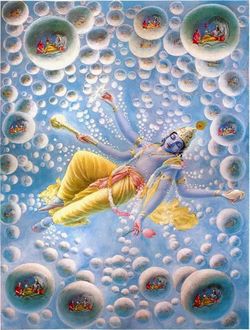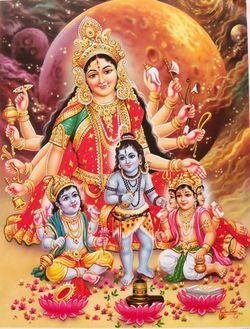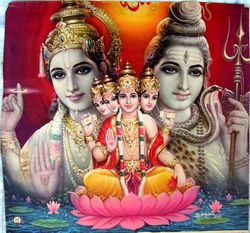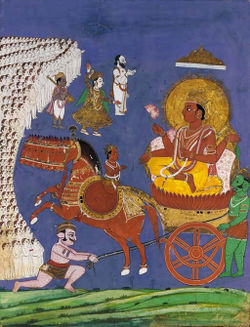Theology
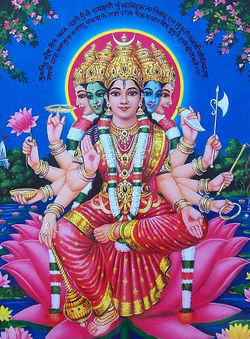
The mantra demonstrates henotheism when it is called Sarva-devata Svarupini ("Universal Form of All Deities.")
“The Hindu religion is the only one of the world’s great faiths dedicated to the idea that the Cosmos itself undergoes an immense, indeed an infinite, number of deaths and rebirths. It is the only religion in which the time scales correspond to those of modern scientific cosmology. Its cycles run from our ordinary day and night to a day and night of Brahma, 8.64 billion years long. Longer than the age of the Earth or the Sun and about half the time since the Big Bang.” - Carl Sagan, Cosmos
Panentheism is the first and foremost theology of the Sanatan Dharm while henotheism and monotheism are secondary but they are all in conformity with each other. This is because while recognizing there is only One Supreme Being above all (Brahm or God), the immanence and transcendence of It is a doctrine that goes beyond the generic monotheism preached by other religions. While accepting there is One God above all, it does not enforce worshiping only The One. So it is monotheistic because it believes there is God, but also henotheistic because others worshipping It in another form is accepted as still worshiping the One God. Worship as polytheism (i.e., praying to ancestors) is acceptable being it does not reject The One but venerates others as well. Once a human attains Moksh, it is united with Brahm or Parmatma. Brahm is not confined to space and so is everywhere, including within ourselves. This principle is Ishavasyam. Individuals on the other hand are also connected to all that exists, and this is the principle of aikatmyam. Because of this omnipresence, the central Hindu theology is panentheism. It is monotheist too because there is just one God above all other spirits. It is henotheist because, while Brahm is The Supreme, other beings worthy of worship exist, which may be pious humans or angels (demi-gods.) Hindu theology is often aptly termed monistic theism and even open monotheism by some scholars, but is not purely polytheistic as outsiders perceive it to be. Worship (Bhakti Yoga) is one of the three yogas to attain Moksh.[1] Monotheism is known in Hindu scriptures as ekantikvad, and some sects practice it strictly, such as the Arya Samaj, Mahima, and certain Śaiva (i.e., Viraśaiva, Alakhgir) and the Vaiṣnava (i.e., Pushtimarga, Ekasarana) sampradays.
Hinduism has often been considered to be polytheistic because of one leading denomination, Smartism, which follows the Advaita philosophy of absolute monism, and includes worship of all kinds of personal forms of God. Absolute monists see one unity with all personal forms of God as different aspects of one Supreme Spirit, like a single beam of light separated into colors by a prism. Thus Smartas consider all personal forms of God as equal including Devi, Vishnu, Śiva, Ganesh and Skanda but generally limit the recognized forms to be six. Other denominations of Hinduism don't adhere to the Smarta viewpoint, but are quite unlike Western perceptions of monotheism. Additionally, like Judeo-Christian traditions which believe in angels, Hindus also believe in other less powerful entities, such as devas.[2]
Sometimes the orthodox members of religions interpret religions with a puritan mindset. An example is that many Christians believe any form of worship not including Jesus as being 'idol worship', while Muslims consider idol worship specifically practicing worship through statues but revering the black stone at the Kaaba and circumambulating Kaaba as not idolatry. [Within the Hindu community too prejudices exist among certain people but the general belief is that 'all religions lead to God'.] This leads to religions discrediting other religions. It is resulted in Hinduism being classified as 'pagan cults' and/or a 'polytheistic religion with no heaven'. The underlying principle of the divine is that it has a Supreme Soul (literally 'Parmatma'), making Hinduism monotheistic in belief. Because Hindus believe that Parmatma possesses the universe, which It also transcends, Hinduism believes in panentheism. And because of the principles 'all religions lead to God' and 'All God is One', and that God can be worshiped in those various ways in various forms, Hinduism believes in henotheism.
Contemporary Hinduism can be categorized into four major sects:
- Vaiṣnavism
- Śaivism
- Śaktism
- Smartism
Vaiṣnavism, Śaivism, and Śaktism worship Vishnu, Śiva and Devi - the Divine Mother as the Supreme Being respectively or considering all Hindu deities as aspects of the Supreme Being or Brahm.[3] Other minor sects such as Ganapatya and Saura focus on Ganesha and Surya as the Supreme.
Nature of God[edit]
- See also: Nature of God
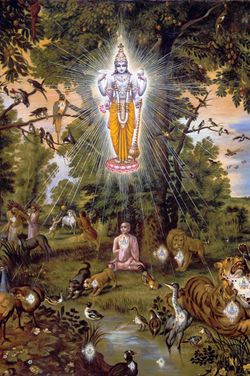
The One Above All is called Brahm and Parmatma in Sanatan Dharm. This Supreme Being is beyond imagination and experience, and as such, transcends the universe. The darshanas (metaphysical worldviews) discuss this universe being prakriti which releases from either Brahm Itself or from human under the influence of ignorance (i.e., Maya.) Brahm is also believed by most Hindus to incarnate in various avataras, which may be to answer a prayer of a devotee, test a human, or promote spirituality (i.e., Krishna.)
Brahm or God Almighty is spoken of as being alaukika ("beyond this world.") This world is seen as prakriti (nature) which God created. This nature of this world is such that karmas cause beings to be possessed with defilements. God is tri-guṇatit, meaning It is transcendental to the modes of material nature.
God is:
- Sarvavyapin (omnipresent)
- Sarvajna (omniscient)
- Sarvashaktiman (omnipotent)
- Akal (without beginning, and forever)
- Tri-gunatit (transcendent of the 3 modes of material nature)
The sarvavyapin aspect of God is such that it pervades everything, both material and spiritual, and is also called Ishavasyam ("God present in all.") Sarvajna means to know all, and this is an aspect often highlighted when speaking of Moksh, because salvation means Brahmgyana ("to know Brahm") or to acquire Brahmvidya. Sarvashaktiman means the power of Brahm is such that there is nothing it cannot do, and no other power is greater. Akal means "timeless" and refers to the self-existent state (swayambhu) of God, and that it will exist forever. Tri-gunatit means to be transcendent of this material universe which is imperfect.
Dualistic Energies of God[edit]
This is an understanding of Brahm based on its energies in this universe. While Brahm is the Supreme above all, the God Almighty, it is said to apply two forms of energies in this world. This means that the energy which surrounds us in this material realm is different from that of the spiritual world (Moksh), as is the energy which is with our souls. This is spoken of in different sects and darshans. For example, in the Śaiva sect, Śiva is said to be Brahm while his other half is Prakriti (the divine energy possessing this world.) In the Samkhya Yoga darshan too, Brahm (Purusha) has a counterpart referred to as Prakriti, which is the nature that surrounds us in this reality. In the Bhagvad Gita too, Krishna says that Brahm is the total energy while the energy here in this reality he calls Parmatma. In Vaiṣnavism, this is notion of the Gita is elaborated wherein the energy of Brahm present in this universe is Mahamaya (or hiraṇmaya-mahat-tattva), whereas in the spiritual one it is Yogamaya (or jivan shakti.) The material energy is impacted by the three modes of material nature whereas spiritual energy is not, which is why prakriti is eternal and mutable (parimaminitya), whereas yogamaya is eternal and immutable (parinamnitya.) The total energy of Brahm is called swarup shakti.
Personification of God's two energies has been presented in some instances as well. In Śaiva context, Śiva represents the spiritual energy and Śhakti Ma represents the material energy. In Vaiṣnavism too, Brahm is Krishna or Narayan and his energy (both spiritual and material) is a female, usually portrayed as Vishnu's wife, Sri (Mantramayi Kriya Shakti.)
Establishing 3 Aspects of God[edit]
Because the energies in the universe have normally been considered to be dualistic, they, together with God's total energy in the spiritual real, would be 3 aspects of God. From this logic, many Hindu thinkers have believed there are 3 aspects of God we can come to the conclusion of. Various scriptures have written on the One Supreme Lord being characterized of 3 aspects, in Hinduism and in the Buddhism and Jainism. In a conversation mentioned in the Brihadaranyaka Upanishad[4] between Yajnavalkya and Vidaghdha, the latter asks how many Devas (gods) there are, to which the former replies 33, but Vidaghdha keeps asking, and before coming to the answer of a single 1 God, he had said there are 3 gods [which can be taken to mean that single God has 3 aspects.] No other story legitimizes 3 aspects of Brahm more than the one of the Rig Veda wherein Vishwakarma produced the universal seed Hiranyagarbha, which produced Prajapati, and with Prajapati having come into being the “one divine spirit.”[2]
While the Pāñcharātra consists of 5 venerable forms of Narayana (para, vyuha, vibhava, arca, and antaryamin), the 3 aspects which as para, vyuha, and antaryamin fall within the same categories as the classifications of Brahm do in many other analyses. The vibhava aspect of God is basically formed from one or 2 of the other aspects (i.e., avatara of vyuha and consist of antaryamin.) Arca refers to representative icons of God which are venerated, which are created by matter. In this analysis, the Pāñcharātra holds consistent with the triune characterization of God.
Below is a table summarizing and forming the connections between the trinity stated in various texts or beliefs.
| Derivation | Heavenly Being | All-Pervasive Being in Universe | Inner Being |
|---|---|---|---|
| Bhagvad Gita[5] | Krishna | Aparabrahm | Parmatma[6] |
| General belief | Parabrahm | Aparabrahm | Aksharbrahm |
| Rig Veda and some Puranas | Vishwakarma | Hiranyagarbha | Prajapati (Vaishvanara) |
| Atharva Veda | - | Virat Hiranyagarbha | Ishvar |
| Sams'aya-taducchedavādah | Manomaya Purush (Avyaya) | Vangmaya (Kshar) | Pranamaya Purush (Akshar) |
| General belief | Purush | Avyaktam | Mahat (Mahan Atma) |
| Vayu Purana 1.2 | Purush | Manifested Prakriti | Unmanifested Prakriti |
| Yoga Sutra 2.20 | Drashtā | Pratyaya-anupashya | Shuddha |
| Isha Upanishad 6-7 | Uttam | Kshar | Akshar |
| General belief | Brahmā | Vishnu | Mahesh |
| Mn Upanishad 24 | Tvashtā | - | - |
| General belief | Sat | Chit | Anand |
| Sasongko Jati | Principle of Lord | Director of Life | Lord of Life |
| Bhagavat Purana | Narayan | Mahamaya | Yogamaya |
| Pāñcharātra belief | Para | Vyuha | Antaryamin |
| Śaiva belief | Shiva | Shakti | Yamala |
Formlessness[edit]
| Knowing That which is soundless, touchless, formless, undecaying; also tasteless, odorless, and eternal; beginningless, endless and immutable; beyond the Unmanifested: (knowing That) man escapes from the mouth of death. | ||
—Katha Upaniṣad 3.15 | ||
Brahm has been written of to be either Nirguna (Parabrahm) and Shaguna (Aparabrahm), including being both. Nirguna refers to God without physical and personality attributes (i.e., a body) while Shaguna is the opposite. Worshiping God as either is fine. Brahm is believed to take vyuhas or emanations, especially to communicate with humans in the physical world (i.e., to provide revelations), and has been seen particularly in Vaiṣnavism as both heavenly and earthly incarnations. Avatars of Śiva, Ganesh, Durga, and others have also been documented and worshipped.
| Brahm has indeed has 2 two modes, formless as well as manifested. | ||
—Brihad-Aranyaka Upaniṣad 2.3.1 | ||
Nirguna bhakti was a popular method of worshipping in the medieval era in particular when several sects appeared. Worshipping Vishnu in the formless manner was practiced by Ramanand Sampraday and its succeeding sects, including Kabir Panth, Ravidas Panth, Satnam Panth, and others. Mahima Dharm was a peculiar Vaiśnava sect because it adheres only to the Bhagvat Purana and normally referred to Vishnu as Alakh or Sunya (“Void.”) Temples of this sect never include idols which are venerated because the heavenly Vishnu, God before the creation of all, is considered unmanifested. Some Śaiva sects too have practiced worship without an idol, denying that God (Śiva) has a form. These sects include Alakhgirs and Nath Panthis, both of whom call Śiva Alakh (“Invisible.”) Manikkavasagar was a well-known saint from the Bhakti era that worshipped Śiva as formless.[7] Arulnanti was a another Śaiva theologian from southern India at the time.
| Although the Supreme Lord is described as having no hands and legs, He nonetheless accepts all sacrificial offerings. | ||
—Śvetāśvatara Upaniṣad 3.19 | ||
Temples wherein Brahm is worshipped as formless are known as Sunya Mandirs. Most of these are Vaiśnava belonging to the Ekasarana, Mahima, and Satnami sects, but Śaiva sects of Brahmā Kumaris are notable. There are also temples of Vishnu, Śiva and other gods that don’t belong to a particular sect.
| The Entity who is one and without a second, and one without any colours; who has created the colourful quinquelemental world for reasons unknown with the help of His many powers; in whom this entire universe dissolves; is no other than Parama Puruśa. Let that Entity guide our intellect along the path of supreme righteousness. | ||
—Śvetāśvatara Upaniṣad 4.1.12 | ||
Immanency and Transcendence of God (Panentheism)[edit]
| I take refuge in that self-existent Being in Whom is this Universe, and Who is beyond this (differentiated Nature) as also beyond that (Undifferentiated.) | ||
Karl Krause coined the term 'panentheism' inspired by his readings on Hinduism.[8] In Sanskrit, this is called Ishavasyam or vibhudyatvad (“doctrine of pervading and surpassing.”) While pantheism equates the visible universe with God, panentheism declares that God is omnipresent in Its creation and transcends Its creation too. This means God is the visible universe and more. Heaven and hell may not be in this universe, but another wherein God is also omnipresent. It would make sense that if God is all-pervasive that we would be within It. In other words, everything is submerged or within God. Purusha Sukta states that The Supreme is both immanent and transcendent - "Sa bhumin vishvato vritva atyatishthat dashangulam." Even when Hindus greet each other by saying "Namaste," it means "I bow to God within you," showing panentheism in the very greeting. The Kaṭha Upaniṣad 2.2.12-13 states, “Whatever we see is a manifestation of Brahman.”[9] Satguru Sivaya Subramuniyaswami, said that "Panentheism is the view that the universe is part of the being of God, as distinguished from pantheism (all-is-God doctrine"), which identifies God with the total reality. In contrast, panentheism holds that God pervades the world, but is also beyond it. He is immanent and transcendent, relative and Absolute. This embracing of opposites is called dipolar. For the panentheist, God is in all, and all is in God."
| It is you from whom this universe of forms emerges, and it is you within whom it stays. It is you in whom it finally disappears. | ||
—Vedasara Shivastotram | ||
Professor Charles Hartshorne in his discussion of panentheism discussed Hinduism in 1953. Professor Lorilai Biernacki considers Hinduism to be one of the most panentheistic traditions.[3] Other Ārya Samudāy dharmas have also been written on by scholars as panentheist - Christopher Key Chapple on Jainism, Geoffrey Samuel on Buddhism, William M. Reynolds on Sikhism[10], Ernest Lee Tuveson on Hermeticism[11], and Dirk Baltzly on Neoplatonism.
"It is in the Vedas that we find for the first time not merely traces or indications of Pantheism, but Pantheism itself in its full growth and maturity." - Constance E. Plumptre[12]
| This entire cosmic manifestation is pervaded by Me in My unmanifest form. All living beings dwell in Me, but I do not dwell in them. | ||
Ishavasyam is a term which demonstrates the omnipresent nature of Brahm, wherein It is everywhere and is transcendent of the objects it possesses. In a story from Krishna's life, once when Krishna was an infant he was suspected to have placed mud into his mouth. Yashoda then said, “If you have not taken any mud, then open your mouth. I shall see for myself.” Upon seeing in his mouth, she saw the universe (i.e., galaxies, starts. ) This one event shows how the universe itself is within God Almighty.
| The Supreme Lord walks and does not walk. He is far away, but He is very near as well. He is within everything, and yet He is outside of everything. | ||
In the below verse, Yama is saying the Brahm is present in the inanimate and animate objects of the world.
| I am the food. I am the eater of food. | ||
—Taittiriya Upaniṣad 3.10.6 | ||
| He who, dwelling in all things,
Yet is other than all things, |
||
—Brihad-Aranyaka Upaniṣad 3.7.15 | ||
The verse below illustrates that God is the Complete Whole, meaning all-pervasive in this universe and yet, transcendent of it:
| God is perfect and complete, and because It is completely perfect, all emanations from It, such as this phenomenal world, are perfectly equipped as complete wholes. Whatever is produced of the Complete Whole is also complete in itself. Because It is the Complete Whole, even through so many complete units emanate from It, It remains the complete balance. | ||
—Isha Upaniṣad invocation | ||
Mahatma Gandhi was very fond of quoting from this Upaniṣadic couplet:
| Whatever is ephemeral in this changing universe is Ishavasya (enveloped by Isha.) | ||
—Isha Upaniṣad | ||
The omnipresence of Brahm is related to the interconnectedness of the soul (aikatmyam), because it is this relationship which also helps connect the soul to Brahm for achieving Moksh - realizing Aham Brahmasmi and tapping into the Antaryamin (Brahm within.)
| That microcosm [within you] is That Universe [outside of you], That Universe [outside of you] is that microcosm [within you.][13] |
||
—Yajur Veda | ||
This concept is mentioned as Pind Brahmand Nyaya.
Oneness of God (Monotheism)[edit]
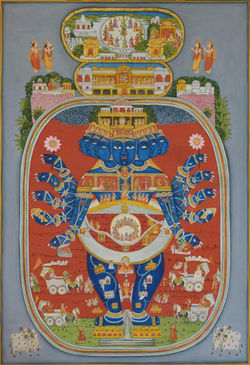
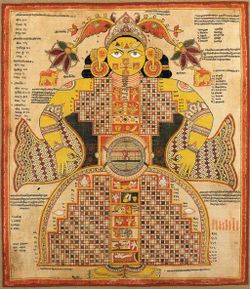
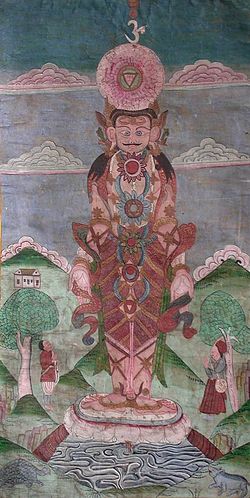
Brahm and Parmatma are the generic terms for The One Above All. The Sanskrit term for this is ekantikvad or ekamata. How Hindus have practiced monotheism is by worshiping Parmatma by worshiping It as an Ishta-Dev. Even the worship of solely Krishna as Parmatma or God Almighty by followers was referred to Ekantika Dharma and Ekayana. The latter term was used also by Vaiśnavas of the Rudra Sampraday for worshipers of only Vishnu. Śaiva sects too have enforced monotheism, such as the Alakh Panth and Virasaivs. Monotheism in worship is enforced by a few sects but worshiping God Almighty along with others (demi-gods and ancestors) isn’t forbidden by most sects.
Oneness of Deities (Henotheism)[edit]
- See also: Worship, Oneness of God
"This concept of God is panentheistic and even the Vedic theism is nothing but panentheism. It is very well expressed in philosophical hymns like Puruṣa sūkta, Hiranyagarbha sūkta and even Nāsadīya sūkta." - Sahebrao Genu Nigal[14]
It is understood that any kind of worship is accepted by The One Above All, regardless of name or form addressed in worship. The Sanskrit term for this is sarvekāntatva (“state of all being a part of one.”) Even a worshiper who is not Hindu and worships God [or a god] at their church or home, is worshiping God (only in a different way.) This particular viewpoint was so profound to modern scholars studying Hinduism that new terms had to be invented in English just to describe it - 'henotheism'. Then from 'henothenism' came another another term - 'kathenotheism' - meaning to worship 1 god at a time (while recognizing there may be more than a single divine being.) Then in 1828 German philosopher Karl Krause coined the term 'panentheism'.
| Of the eternals you are The Chief Eternal, of the sentients you are The Chief Sentient The One Chief of the many, that assembles and who is desirable |
||
—Katha Upaniṣad 2.2.13[15] | ||
Even the earlier Mandalas of Ṛgveda[16] which contain hymns dedicated to devas, are thought to have a tendency toward monotheism.[17] Often quoted isolated pada of the Ṛgveda[18] states (trans. Ralph T.H. Griffith):
| English | Sanskrit | ||||||
|---|---|---|---|---|---|---|---|
|
|
Further, the Ṛg Veda states, “There is only one God, worship Him“[19] and “Do not worship any one beside Him“[20]. Recognizing that there is a Supreme God above any other divinities is seen in the Vaiśnava mantra “Dev devaya namo nama” and Śaiva mantra “Aum nama Shivay sarvaya deva devaya vai namaha,” both of which proclaim their respective Supreme as the “God of gods.”
| Patiṁ patīnāṁ paramaṁ parastāt | ||
—Śvetāśvatara Upaniṣad 6.7 | ||
The Brahma Samhitā[21] declares, Lord Vishnu is milk; Lord Śiva is yogurt. Other aspects of God are expansions or aspects of Vishnu or Śiva which is detailed in various Purānas. Vaiṣnavites, like other Hindus, have tolerance for other beliefs because Krishna, an avatara of Vishnu, said so in the Gitā. Krishna says:
| Whatever deity or form a devotee worships, I make his or her faith steady. However, their wishes are only granted by Me alone."[22] | ||
—Bhagvad Gita 7.21-22 | ||
Krishna also says in the Gitā:
| O Arjuna, even those devotees who worship other lesser deities e.g., devas, with faith, they also worship Me, but in an improper way because I am the Supreme Being. I alone am the enjoyer of all sacrificial services (Seva, Yajna) and Lord of the universe."[23] | ||
The theology of henotheism also applies to the treating of ancestors or other beings as venerable. Because divinity is extended to them by many Hindus, it does not mean that there is a violation of the belief in a One God Above All, but that piety is offered to them in respect.
| The Lord of lords is Supreme and beyond them (deities.) | ||
—Śvetāśvatara Upaniṣad 6.7 | ||
Smarta view[edit]
The system prevalent in Hinduism is defined by the Smartha philosophy; this theory allows for the veneration of numerous deities, but on the understanding that all of them are but manifestation of the one divine power.[24] That ultimate divinity is termed Brahm or Atman and is believed to have no specific form, name or attribute.[25] Only a Smartha, or follower of the Advaita philosophy, would have no problem worshiping every imaginable deity with equal veneration; as the view is that all names and forms of deities are merely manifestations of the same God. Other Hindu sects such as Vaiṣnavism and Śaivism conform more closely to a Western understanding of what a monotheistic faith is. For instance, a Vaiṣnavite considers Vishnu as being the one and only true God, an attitude that resonates with that of the Abrahamic religions. However, it is Advaita philosophy that defines the Smartha sect of mainstream Hinduism, and imparts to Indic spiritual and religious traditions their renowned liberalism.
Swaminarayan view[edit]
Swami Sahajananda, founder of the Swaminarayan Sampraday, said in verse 115 of its scripture, “Śikśapatri said, ‘Sri Krishna Bhagvan and Sri Krishna Bhagvan's incarnations alone are worthy of meditation. Similarly, Sri Krishna Bhagvan's images are worthy. And men or devas, even if they are devotees of Sri Krishna Bhagvan or Brahmvetta,[26] They are still not worthy of meditation and thus one should not meditate upon them.’"
The Brahma Samhitā[27] declares, Lord Vishnu is milk; Lord Śiva is yogurt.[28] Followers of Swaminaryan are Vaiṣnavas, but differ from the viewpoint attested by Gaudiya Vaiṣnavas who emphasize Śiva as a subordinate demigod expansion of Krishna. For example, Swaminaryan states: [29]
| And the oneness of Narayan and Śiva should be understood, as the Vedas have described both to be Brahmarupa (or form of Brahm, i.e., Saguna Brahm), thus indicating that Vishnu and Śiva are different forms of the one and same God. And that Ishvara is Sri Krishna Bhagvan,[30] who is supreme Parabrahm, Purushottam, our Ishta-deva[31] worthy of worship, and the cause of all incarnations. | ||
—Shikshapatri 47.84.108 | ||
Vivekanandian view[edit]
According to the speech of Swami Vivekananda in Chicago during 1906, the monotheism of Hindu is not only for Hindu. It can effective for every human living on the earth. The verse,
| English | Sanskrit | ||||||
|---|---|---|---|---|---|---|---|
|
|
Relation Between Brahm and Individuals[edit]
Sanatan Dharm is essentially to understand the relationship between the Self and self, which is why the phrases "Aham Brahmasmi" and "Ayamatma Brahm", both of which mean, "I am part of the Supreme."
Upaniṣad Era[edit]
In the time period that the Upaniṣads were written, worship of gods within Hindus is turning into worship of primarily one god. The Chāndogya Upaniṣad states,
| God is only one, not a second.“ | ||
—Chāndogya Upaniṣad Ch. 6.2.1 | ||
The Rudra Upaniṣad from the Atharva Shiras Upaniṣad reads of Rudra declaring himself as Brahm, and describing his attributes. The text also reads:
| O Rudra, O Ishana, O Maheshwara, O Mahadeva, O lord, for thou art Parabrahm, the one and only god![32] |
Bhakti movement[edit]
- See also: Bhakti movement, Bhakti, Bhakti Yoga
Krishnaism is one notable instance of Vaiṣnava monotheism popularized in the Bhakti movement. Krishnaism refers to Krishna with the title Svayam Bhagvan, meaning 'Lord Himself' and it is used exclusively to designate Krishna as the Supreme Lord.[33] Certain other traditions of Hinduism consider Krishna to be the source of all emanations,[34] and the source of Vishnu himself or to be the same as Narayan.[35][36][37] The term is seldom used to refer to other forms of Krishna and/or Vishnu within the context of certain religious texts such as the Bhagvata Purāṇa.
Though Krishna is recognized as Svayam Bhagvan by many,[38] he is also perceived and understood from an eclectic assortment of perspectives and viewpoints.[39] When Krishna is recognized to be Svayam Bhagvan, it can be understood that this is the belief of Gaudiya Vaiṣnavism,[40] the Vallabha Sampradaya,[41] and the Nimbarka Sampradaya, where Krishna is accepted to be the source of all other manifestations and the source of Vishnu himself. This belief is drawn primarily from the famous statement of the Bhagvatam[42]:[43]
| All of the descents and incarnations are either plenary portions or portions of the plenary portions of the Lord, but Lord Śrī Krishna is the original Personality of Godhead. | ||
—Srimad Bhagvatam[44] | ||
Vaiṣnavism is one of the earliest implicit manifestations of monotheism in the traditions of Vedas. Svayam Bhagvān is a Sanskrit term for the original deity of the Supreme God worshiped across many traditions of the Vaiṣnavism as the source of all, the monotheistic absolute Deity.[35][36]
[45] Within Hinduism, Krishna is worshiped from a variety of perspectives.[39] However, the Svayam Bhagvan concept refers to the Supreme Being of the Orthodox Gaudiya Vaiṣnavism,[40] the Vallabha Sampradaya and the Nimbarka Sampradaya, where Krishna is worshiped as the source of all other avataras (including Vishnu).[46]
[47]
[48] A distinguishing feature of the Vaisnava teachings is that God, Krishna or Vishnu,[36] is a real person and His variegated creation is also real.[36][49]
Krishna worshiped in Vaiṣnava religion as the Supreme came into being as soon as all creatures came into existence. Brahma was the first Vaiṣnava. In Gaudiya Vaiṣnavism, Śiva Mahadeva is also a Vaiṣnava; in Śaivism, by contrast, Śiva is the supreme God. The ancient Prajapaties are all Vaiṣnavas. Narada who is the born child of Brahma, is a Vaiṣnava. Thus pure monotheistic Vaiṣnava religion began with the beginning of history.[49] In the recent times man arrived once again at the instinctive monotheism of the Aryans and Vaiṣnavas.[50]
A different viewpoint, opposing this theological concept, is the concept of Krishna as an avatara of Narayan or Vishnu. However, although its is usual to speak of Vishnu as the source of the avataras, this is only one of the names of god of Vaiṣnavism, who is also known as Vishnu to some Vaiṣnava, Narayan to some, Vasudeva, or any of the other Vaiśnava persons, and behind each of those names there is a divine figure with attributed supremacy in Vaisnavism.[51] The theological interpretation of Svayam Bhagvān differs with each tradition and the translated from the Sanskrit language, the term literary means "Bhagvan Himself" or "directly Bhagvan".[42] Gaudiya Vaiṣnava tradition often translates it within its perspective as primeval Lord or original Personality of Godhead, but also considers the terms such as Supreme Personality of Godhead and Supreme God as an equivalent to the term Svayam Bhagvan, and may also choose to apply these terms to Vishnu, Narayan and many of their associated avatars.[52]
"Krishna is the primeval Lord, the original Personality of Godhead, so He can expand Himself into unlimited forms with all potencies."[53][54] Others have translated it simply as "the Lord Himself".[55] Followers of Vishnu-centered sampradayas of Vaiṣnavism rarely address this term, but believe that it refers to their belief that Krishna is among the highest and fullest of all avatars[56]
Sri Krishna stands at the top of this series. He is therefore called by his votaries as Purna Avatara or the highest and fullest incarnation of the Lord. and is considered to be the "paripurna avatara", complete in all respects and the same as the original.[57] Parashara Maharishi, Vyāsa's father had devoted the largest Aṅṣa[58] in Vishnu Purāṇa to the description of Sri Krishna Avatara the Paripoorna Avatara. And according to Lord Krishna's own instructions upadeṣa, "he who knows the secrets of His (Krishna's) Janma[59] and Karma[60] will not remain in saṅsāra[61] and attain Him after leaving the mortal coil."[62] Parāsara Maharishi ends up Añṣa 5 with a phalashruti in an identical vein (Vishnu Purāna[63].)
The prime supporters of the Krishna-centered theology, Gaudiya Vaiṣnavas and followers of the Vallabha Sampradāya Nimbarka Samprādaya, use the Gopala Tapani Upaniṣad,[64] Vedanta Sutras[42] and other Hindu scriptures such as the Bhagvata Purāna and the Brahma Vaivarta Purāna, among others, to support their view that Krishna is indeed the Svayam Bhagvan. This belief was summarized by the 16th century author Jiva Goswami in some of his works, such as Krishna-sandarbha.[42][65] While Krishna himself if mentioned in one of the earliest texts of Vedic literature - Ṛgveda.[66]
In the sixth book of the Hindu epic Mahābhārata, the Bhishma Parva[67] Krishna offers numerous quotations that reaffirm the belief that he himself is the Svayam Bhagvan. Verse 7.7 of the Bhagvad Gitā, is often used to support the opinion that Krishna himself is the Svayam Bhagvan, and that no impersonal form of Brahm supersedes his existence, as it is a common view that Bhagvad Gitā was propounding Krishna-theism before first major proponents of monism of the Smarta school.[68]
Related Articles[edit]
External Resources[edit]
- "Panentheism and the Reality of God" By Timothy Conway, Ph.D. (Published: October 2, 2015)
- “Panentheism and Hindu Tantra: Abhinavagupta’s Grammatical Cosmology” By Loriliai Biernacki
References[edit]
- ↑ The other two are Gyāna Yoga and Karma Yoga.
- ↑ Template:Cite book
- ↑ See Advaita, or impersonalism.
- ↑ Chapter 3, Part 9 of Brihadaranyaka Upanishad
- ↑ “O best of the embodied souls, the physical manifestation that is constantly changing is called adhibhūta; the universal form of God, which presides over the celestial gods in this creation, is called adhidaiva; I, who dwell in the heart of every living being, am called Adhiyajña, or the Lord of all sacrifices.” - Bhagvad Gita 8.4
- ↑ “Within the body also resides the Supreme Lord. He is said to be the Witness, the Permitter, the Supporter, Transcendental Enjoyer, the ultimate Controller, and the Paramātmā (Supreme Soul).” - Bhagvad Gita 13.23
- ↑ Shiva in the City of Nectar: Fifty-four divine tales of Shiva in ancient India By Preetha Rajah Kannan
- ↑ P. 170 The Oxford Handbook of Natural Theology By Russell Re Manning; Karl Krause (1781–1832) borrowed Indian ideas in formulating his own panentheist doctrine of God as a non-personal essence (Wesen) with which the world must eventually be reunited."
- ↑ “sarvaṁ khalv idaṁ brahma taj jalāniti śānta upāsīta”
- ↑ P. 90 Expanding Curriculum Theory: Dis/positions and Lines of Flight By William M. Reynolds and Julie A. Webber
- ↑ P. 255 Gnosis and Hermeticism from Antiquity to Modern Times By R. van den Broek
- ↑ General Sketch of the History of Pantheism: Volume 1 By Constance E. Plumptre
- ↑ Yat pinde tatha Brahmānde
yatha Brahmande tatha pinde[1] - ↑ P. 81 Vedic Philosophy of Values By Sahebrao Genu Nigal
- ↑ Nityo nityanam cetanas cetananam
eko bahunam yo vidadhati kaman
tam atma-stham ye ’nupasyanti dhiras
tesham shantih sasvati netaresam - ↑ Ṛgveda books 1 and 9
- ↑ Macdonell, Arthur Anthony. Vedic Mythology. Forgotten Books (May 23, 2012). P. 17. ISBN 1440094365.
- ↑ Ṛgveda 1.164.46
- ↑ Ṛg Veda, 6.45.16
- ↑ Ṛg Veda 8.1.1
- ↑ Brahma Samhitā 5.45
- ↑ Gitā 7.21-22
- ↑ Gitā 9.23
- ↑ It is a belief sometimes called kathenotheism.
- ↑ Template:Cite book
- ↑ It is knower of divinity.
- ↑ It means Brahma Samhitā 5.45
- ↑ http://vedabase.net/bs/5/45/en Sri Bramha Samhita 5.45
- ↑ Shree Swaminarayan Temple Cardiff - Scriptures - Shikshapatri
- ↑ (Sri Swaminarayan Bhagvan
- ↑ It means principal deity.
- ↑ P. 443 Researches Into the Nature and Affinity of Ancient and Hindu Mythology By Vans Kennedy
- ↑ Gupra, 2007, p.36 note 9.
- ↑ Bhagwan Swaminarayan bicentenary commemoration volume, 1781-1981. p. 154: ...Shri Vallabhacharya [and] Shri Swaminarayan...Both of them designate the highest reality as Krishna, who is both the highest avatara and also the source of other avataras. To quote R. Kaladhar Bhatt in this context. "In this transcendental devotion (Nirguna Bhakti), the sole Deity and only" is Krishna. New Dimensions in Vedanta Philosophy - Page 154, Sahajānanda, Vedanta. 1981
- ↑ 35.0 35.1 Template:Cite journal Cite error: Invalid
<ref>tag; name "Delmonico2004" defined multiple times with different content - ↑ 36.0 36.1 36.2 36.3 Template:Cite book Cite error: Invalid
<ref>tag; name "Elkman1986" defined multiple times with different content - ↑ Template:Cite book page 132
- ↑ Template:Cite bookpp.234-239
- ↑ 39.0 39.1 Template:Cite journal Cite error: Invalid
<ref>tag; name "Mahony1987" defined multiple times with different content - ↑ 40.0 40.1 Template:Cite book Cite error: Invalid
<ref>tag; name "Kennedy1925" defined multiple times with different content - ↑ Template:Cite book"Early Vaiṣnava worship focuses on three deities who become fused together, namely Vasudeva-Krishna, Krishna-Gopala and Narayana, who in turn all become identified with Vishnu. Put simply, Vasudeva-Krishna and Krishna-Gopala were worshiped by groups generally referred to as Bhagvatas, while Narayana was worshiped by the Pancaratra sect."
- ↑ 42.0 42.1 42.2 42.3 Template:Cite book
- ↑ Essential Hinduism S. Rosen, 2006, Greenwood Publishing Group p.124 ISBN 0-275-99006-0
- ↑ Śrimad Bhagvatam1.3.28
- ↑ Template:Cite journal
- ↑ Template:Cite book
- ↑ Bhag 1.3.28 Chapter 3: Krishna Is the Source of All Incarnations
- ↑ See McDaniel, June, "Folk Vaishnavism and Thākur Pañcāyat: Life and status among village Krishna statues" in Template:Harvnb
- ↑ 49.0 49.1 Template:Cite journal
- ↑ Template:Cite journal
- ↑ Template:Harvnb
- ↑ name=Knapp2005>{{cite book | author = Knapp, S. | year = 2005 | title = The Heart of Hinduism: The Eastern Path to Freedom, Empowerment and Illumination - | publisher = iUniverse | isbn =
- ↑ page 161
- ↑ Template:Cite journal..."Bhakti, the highest path, was that of surrender to Lord Krishna, the way of pure devotional service to the Supreme Personality of Godhead".
- ↑ Template:Cite book p.109 Klaus Klostermaier translates it simply as "the Lord Himself"
- ↑ {{cite book | author = Bipin Chandra Pal | year = 1964, 132 pages | title = Shree Krishna: Letters Written to a Christian Friend | publisher = Yugayatri/New India Printing & Publishing Co. | quote = First edition published in 1938 under the title of 'Europe asks: who is Shree Krishna'. | isbn =
- ↑ "Sapthagiri". www.tirumala.org. http://www.tirumala.org/sapthagiri/122002/purana.htm. Retrieved on 2008-05-03.
- ↑ It means part.
- ↑ It means birth.
- ↑ It means actions.
- ↑ punar janma naiti-maam eti.
- ↑ Bhagvad Gita 4.9
- ↑ Vishnu Purāna 5.38.94
- ↑ Template:Cite book
- ↑ Template:Cite book
- ↑ Sunil Kumar Bhattacharya Krishna-cult in Indian Art. 1996 M.D. Publications Pvt. Ltd. ISBN 81-7533-001-5 p.126: "According to (D.R.Bhadarkar), the word Krishna referred to in the expression 'Krishna-drapsah' in the Ṛgveda, denotes the very same Krishna".
- ↑ It is better known as the Bhagvad Gitā.
- ↑ Template:Cite book

